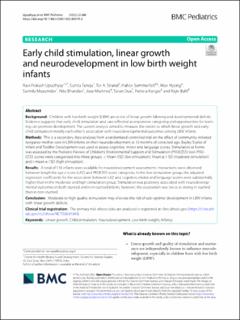| dc.contributor.author | Upadhyay, Ravi Prakash | |
| dc.contributor.author | Taneja, Sunita | |
| dc.contributor.author | Strand, Tor Arne | |
| dc.contributor.author | Sommerfelt, Halvor | |
| dc.contributor.author | Hysing, Mari | |
| dc.contributor.author | Mazumder, Sarmila | |
| dc.contributor.author | Bhandari, Nita | |
| dc.contributor.author | Martines, Jose Carlos | |
| dc.contributor.author | Dua, Tarun | |
| dc.contributor.author | Kariger, Patricia | |
| dc.contributor.author | Bahl, Rajiv | |
| dc.date.accessioned | 2022-12-19T15:04:52Z | |
| dc.date.available | 2022-12-19T15:04:52Z | |
| dc.date.created | 2022-10-21T13:48:49Z | |
| dc.date.issued | 2022 | |
| dc.identifier.issn | 1471-2431 | |
| dc.identifier.uri | https://hdl.handle.net/11250/3038667 | |
| dc.description.abstract | Background
Children with low birth weight (LBW) are at risk of linear growth faltering and developmental deficits. Evidence suggests that early child stimulation and care reflected as responsive caregiving and opportunities for learning can promote development. The current analysis aimed to measure the extent to which linear growth and early child stimulation modify each other’s association with neurodevelopmental outcomes among LBW infants.
Methods
This is a secondary data analyses from a randomized controlled trial on the effect of community-initiated kangaroo mother care in LBW infants on their neurodevelopment at 12 months of corrected age. Bayley Scales of Infant and Toddler Development was used to assess cognitive, motor and language scores. Stimulation at home was assessed by the Pediatric Review of Children’s Environmental Support and Stimulation (PROCESS) tool. PROCESS scores were categorized into three groups: < Mean-1SD (low stimulation); Mean ± 1 SD (moderate stimulation) and > mean + 1SD (high stimulation).
Results
A total of 516 infants were available for neurodevelopment assessments. Interactions were observed between length for age z-score (LAZ) and PROCESS score categories. In the low stimulation group, the adjusted regression coefficients for the association between LAZ and cognitive, motor and language scores were substantially higher than in the moderate and high stimulation group. Stimulation was positively associated with neurodevelopmental outcomes in both stunted and non-stunted infants; however, the association was twice as strong in stunted than in non-stunted.
Conclusion
Moderate to high quality stimulation may alleviate the risk of sub-optimal development in LBW infants with linear growth deficits. | en_US |
| dc.language.iso | eng | en_US |
| dc.publisher | BMC | en_US |
| dc.rights | Navngivelse 4.0 Internasjonal | * |
| dc.rights.uri | http://creativecommons.org/licenses/by/4.0/deed.no | * |
| dc.title | Early child stimulation, linear growth and neurodevelopment in low birth weight infants | en_US |
| dc.type | Journal article | en_US |
| dc.type | Peer reviewed | en_US |
| dc.description.version | publishedVersion | en_US |
| dc.rights.holder | Copyright 2022 The Author(s) | en_US |
| dc.source.articlenumber | 586 | en_US |
| cristin.ispublished | true | |
| cristin.fulltext | original | |
| cristin.qualitycode | 1 | |
| dc.identifier.doi | 10.1186/s12887-022-03579-6 | |
| dc.identifier.cristin | 2063754 | |
| dc.source.journal | BMC Pediatrics | en_US |
| dc.relation.project | Norges forskningsråd: 223269 | en_US |
| dc.identifier.citation | BMC Pediatrics. 2022, 22, 586. | en_US |
| dc.source.volume | 22 | en_US |

